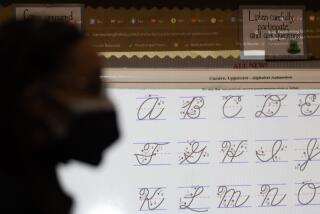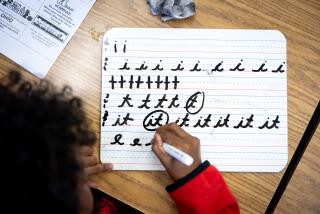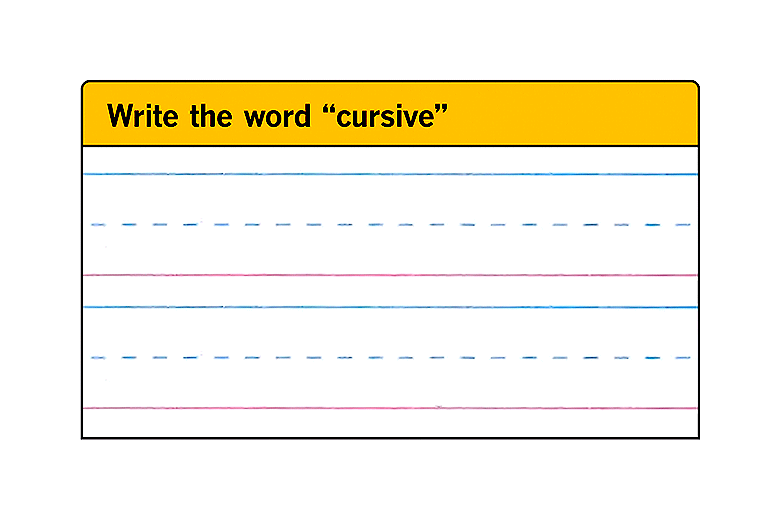Teaching children the art of putting pencil to paper
CARLA RIVERA — For the past two weeks, Grace and Tess Heagy have bounded out of bed each morning anxious for camp, where they sing, paint, dance and practice their penmanship.
Penmanship?
At Handwriting Heroes Summer Camp, Captain Pencil is the resident superhero and mastery of r’s, m’s, n’s, p’s, and other letters earns high praise.
At a time when summer enrichment camps trend toward the high tech -- there are camps for budding astronomers, those for enhancing computer skills and filmmaking -- handwriting camp may seem old school. But it is part of recent efforts to refocus attention on what many educators lament may be the dying art of legible printing and graceful cursive.
Monica Fortunato, a licensed occupational therapist who specializes in handwriting, said she decided to hold summer camps for the first time this year as an extension of her private practice.
“Children have more fun in a small group and it’s helpful for the parents to have instruction in a block of time,” said Fortunato, who is holding the $240 two-week sessions in her Hermosa Beach home with the help of her sister Marie Frank, who is also an occupational therapist. “And in the South Bay, everybody is about summer camp. It had to be fun.”
Some of Fortunato’s clients have developmental challenges that impede their motor skills. Others write slowly or sloppily, having never been taught properly, and need to catch up to their peers, she said. The goal is to promote good writing habits in a fun atmosphere.
The six students, ages 4 to 8, spend time doing physical activities such as the grip relay, using large orange tongs to strengthen finger muscles for writing, and molding clay into the superhero of their choice. They also trace letters on a blackboard and use scented markers to write r’s that turn into n’s and then into m’s on Fortunato’s glass patio doors.
Grace, 8, said she wants to be a singer when she grows up, but she also wants to have good handwriting.
“I like doing words and sentences and letters and pictures,” she said. “I think it’s fun.”
Her mother, Leanore Heagy, said she enrolled her daughters in the camp after Tess, 5, struggled to keep up with her kindergarten classmates.
“People feel handwriting is not as important because of computers, but there will always be a need whether it’s on tests or job applications and children need to be taught how to write correctly,” said Heagy, a former kindergarten teacher.
Mariana Donahoe’s daughter Claire, 6, has trouble with large motor skills but made progress during the camp.
“I know she will never have perfect handwriting, but we’re trying to support her and give her every chance,” said Donahoe, an elementary school teacher. “Here, it’s not being approached with the same pressure stemming from school. It’s much more creative and I don’t think she thinks it’s work.”
California standards call for penmanship instruction in kindergarten through fourth grade, which includes writing upper and lower case letters, proper form and spacing and writing in fluid cursive and other styles, said Alison Towery, a specialist in the Los Angeles Unified School District’s Office of Curriculum, Instruction, and School Support. Teachers in the district provide weekly lesson plans and students use workbooks to self-correct their own penmanship, she said.
Fortunato and Frank, who works in schools, said that many teachers have not been taught how to teach handwriting and are under pressure to spend classroom time preparing students for standardized tests.
A recent Vanderbilt University study found that students with better handwriting are judged more favorably by teachers and earn better grades. In 2005, the SAT tests introduced a handwritten essay section.
Jan Z. Olsen, founder of Handwriting Without Tears, a handwriting curriculum used in many American and foreign schools and by Fortunato, said that handwriting skills began to wane in the 1970s when focus “shifted to expressive writing, to skills of persuasion and description, to content rather than form.”
Students lost the ability to punctuate and space letters properly or even how to form letters, Olsen said. Instant and text messaging have exacerbated the problems, she said, but there has been a resurgence of interest in handwriting.
Although Olsen doesn’t track the number of summer camps using her handwriting curriculum, almost 1,000 educators and occupational therapists signed up for a website seminar on handwriting summer camps this year, she said.
Fortunato said the summer classes help youngsters stay at pace in early grades where they are expected to be adept at skills that used to be introduced in higher grades. She said she is already planning next year’s camps and wants to have separate sessions for kindergarten students, pre-kindergarten and older students. “If I can introduce these concepts before kindergarten, they’ll be better prepared for learning.”
--







